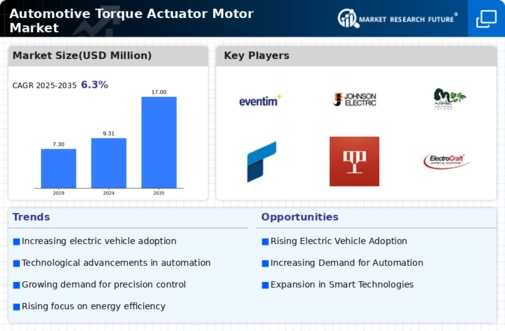Market Growth Projections
The Global Automotive Torque Actuator Motor Market Industry is projected to experience substantial growth, with estimates indicating a market size of 17.0 USD Billion by 2035. This growth is driven by various factors, including technological advancements, regulatory support, and increasing consumer demand for electric vehicles. The anticipated CAGR of 5.64% from 2025 to 2035 reflects the industry's potential as it adapts to evolving market dynamics and consumer preferences. As the automotive landscape transforms, the torque actuator motor market is poised for significant expansion.
Rising Demand for Electric Vehicles
The increasing global emphasis on sustainability and environmental concerns drives the demand for electric vehicles (EVs). As automakers pivot towards electrification, the Global Automotive Torque Actuator Motor Market Industry experiences heightened demand for torque actuator motors, which are essential for various EV functionalities. In 2024, the market is projected to reach 9.31 USD Billion, reflecting the growing integration of advanced technologies in EVs. This trend is likely to continue as consumer preferences shift towards greener alternatives, suggesting a robust growth trajectory for the industry.
Growing Focus on Vehicle Safety Features
The increasing consumer focus on vehicle safety features significantly impacts the Global Automotive Torque Actuator Motor Market Industry. As safety becomes a paramount concern, automakers are integrating advanced safety technologies that rely on torque actuator motors for optimal functionality. Features such as electronic stability control and adaptive cruise control require precise motor control, driving the demand for high-quality actuators. This trend is likely to persist as consumers prioritize safety in their purchasing decisions, suggesting a sustained growth trajectory for the industry.
Regulatory Support for Emission Reductions
Government regulations aimed at reducing vehicle emissions play a crucial role in shaping the Global Automotive Torque Actuator Motor Market Industry. Stricter emission standards compel automakers to adopt technologies that improve fuel efficiency and reduce carbon footprints. Torque actuator motors are integral to achieving these objectives, as they optimize engine performance and enhance overall vehicle efficiency. As countries worldwide implement more stringent regulations, the demand for these motors is likely to increase, thereby driving market growth and innovation in the automotive sector.
Technological Advancements in Automotive Systems
Technological innovations in automotive systems, such as advanced driver-assistance systems (ADAS) and automated driving technologies, significantly influence the Global Automotive Torque Actuator Motor Market Industry. These advancements necessitate the incorporation of sophisticated torque actuator motors to enhance vehicle performance and safety. As manufacturers invest in research and development to create smarter vehicles, the demand for high-performance torque actuators is expected to rise. This trend may contribute to the market's growth, with projections indicating a CAGR of 5.64% from 2025 to 2035, underscoring the industry's potential.
Expansion of Automotive Manufacturing in Emerging Markets
The expansion of automotive manufacturing in emerging markets contributes to the growth of the Global Automotive Torque Actuator Motor Market Industry. Countries such as India and Brazil are witnessing a surge in vehicle production, driven by rising disposable incomes and urbanization. This growth creates a substantial demand for torque actuator motors, which are essential for modern vehicles. As these markets continue to develop, the industry is expected to see increased investments and innovations, further propelling the demand for torque actuator motors in the coming years.



















Leave a Comment